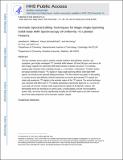Aromatic spectral editing techniques for magic-angle-spinning solid-state NMR spectroscopy of uniformly 13C-labeled proteins
Author(s)
Schmidt-Rohr, Klaus; Williams, Jonathan Kyle; Hong, Mei
Downloadnihms729072.pdf (2.645Mb)
PUBLISHER_CC
Publisher with Creative Commons License
Creative Commons Attribution
Terms of use
Metadata
Show full item recordAbstract
The four aromatic amino acids in proteins, namely histidine, phenylalanine, tyrosine, and tryptophan, have strongly overlapping ¹³C chemical shift ranges between 100 and 160 ppm, and have so far been largely neglected in solid-state NMR determination of protein structures. Yet aromatic residues play important roles in biology through π-π and cation-π interactions. To better resolve and assign aromatic residues' ¹³C signals in magic-angle-spinning (MAS) solid-state NMR spectra, we introduce two spectral editing techniques. The first method uses gated ¹H decoupling in a proton-driven spin-diffusion (PDSD) experiment to remove all protonated ¹³C signals and retain only non-protonated carbon signals in the aromatic region of the ¹³C spectra. The second technique uses chemical shift filters and ¹H-¹³C dipolar dephasing to selectively detect the Cα, Cβ and CO cross peaks of aromatic residues while suppressing the signals of all aliphatic residues. We demonstrate these two techniques on amino acids, a model peptide, and the microcrystalline protein GB1, and show that they significantly simplify the 2D NMR spectra and both reveal and permit the ready assignment of the aromatic residues' signals.
Date issued
2015-09Department
Massachusetts Institute of Technology. Department of ChemistryJournal
Solid State Nuclear Magnetic Resonance
Publisher
Elsevier
Citation
Williams, Jonathan K. et al. “Aromatic Spectral Editing Techniques for Magic-Angle-Spinning Solid-State NMR Spectroscopy of Uniformly ¹³C-Labeled Proteins.” Solid State Nuclear Magnetic Resonance 72 (November 2015): 118–126. © 2015 Elsevier Inc
Version: Author's final manuscript
ISSN
0926-2040